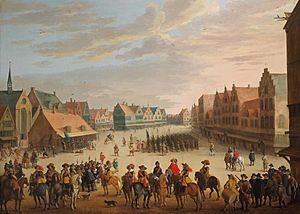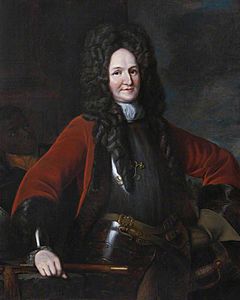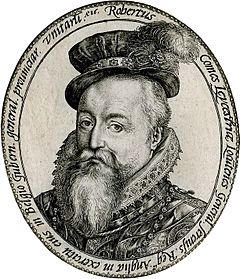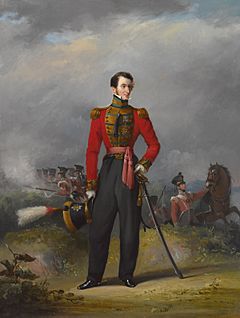Scots Brigade facts for kids
Quick facts for kids Scots Brigadeaka Anglo-Dutch Brigade aka Anglo-Scots Brigade |
|
|---|---|

Scots mercenaries in Utrecht, 1618
|
|
| Active | ca 1586–1782 |
| Country | |
| Branch | Army |
| Type | Infantry |
| Size | Brigade; between three and six regiments |
| Garrison/HQ | Dutch Barrier forts |
| March | The "Scottish March" |
| Engagements | Eighty Years' War Franco-Dutch War Battle of Seneffe Nine Years' War Steenkerque War of the Spanish Succession War of the Austrian Succession Fontenoy; Rocoux; Lauffeld |
| Commanders | |
| Notable commanders |
Earl of Leicester Francis Vere Lt-General Hugh Mackay |
The Scots Brigade, also known as the Anglo-Dutch Brigade, was a special group of soldiers in the Dutch States Army. It was first formed around 1586. By the late 1600s, it usually had six groups of soldiers called regiments. Three of these regiments were mostly from Scotland, and three were from England. This brigade was finally ended in 1782 when the Fourth Anglo-Dutch War started.
For a long time, many European countries used soldiers from other lands, called mercenaries. In Britain, people didn't like the idea of having a big permanent army. So, British kings used the Scots Brigade to train officers. These officers could then be called back to Britain if needed. However, over time, it became harder to recruit soldiers in Britain for the Brigade. After 1757, it was completely stopped.
After the War of the Spanish Succession ended in 1714, the Brigade became smaller. It was mainly used to guard important forts called the Barrier forts. By 1782, many of its officers were British, often from families who had served in the Brigade for a long time. But most of the regular soldiers were born in the Netherlands. The Brigade then became regiments 22, 23, and 24 of the regular Dutch army. After 1784, it was no longer a separate unit. Its history and battle honors were carried on by the 94th Foot until 1881.
Contents
How the Scots Brigade Started (1586–1648)
The Dutch people fought for their freedom from Spain in the Eighty Years' War (1568 to 1648). Many Protestants from across Europe, including England and Scotland, supported them. The first group of these volunteers was "Thomas Morgan's Company of Foot" in 1572. These 300 volunteers from London helped in battles like the Relief of Goes and the defense of Delft.
In 1586, after the Treaty of Nonsuch, the Earl of Leicester made the Brigade bigger. He added three English regiments to the three Scottish ones that already existed. Even though his mission didn't go well, the Brigade continued to fight. They were led by Sir Francis Vere and fought under Maurice of Nassau. New fighting methods were developed in the 1580s. Soldiers started using smaller, faster groups instead of big, slow squares. They also began using "volley fire" where many soldiers shot at the same time.
These new methods meant that professional soldiers were preferred over local citizen armies. Both King James I and King Charles I of England encouraged people to join the Brigade. They saw it as a way to influence other countries. It also gave them a group of trained soldiers they could call on if needed.
The Thirty Years' War (1618-1648) offered many chances to serve in other armies, like those of Sweden or Denmark. So, serving in the Dutch army became less popular. The Brigade was mostly used for guarding duties. However, many Scots still joined because of strong religious, economic, and cultural ties between Scotland and the Netherlands. When the Wars of the Three Kingdoms started in Britain in 1638, many soldiers returned home. But the Brigade kept serving the Dutch army until the Peace of Münster ended the war with Spain in 1648.
Changes and Challenges (1648–1697)

In the late 1600s, people in Scotland and England didn't want a large standing army. This was because of past conflicts like the Wars of the Three Kingdoms. So, groups like the Scots Brigade were a way for Scots and English people to have a military career. Professional officers often moved between different armies, no matter their nationality or beliefs. Many armies at the time had soldiers from different countries. For example, in 1672, many French army groups were recruited from outside France.
During the Second Anglo-Dutch War (1665–1667), officers had to promise loyalty to the Dutch government. Many refused. The English regiments were removed in 1665, brought back in 1667, and then removed again when the Third Anglo-Dutch War began in 1672. The alliance between England and France was very unpopular. While the Franco-Dutch War continued until 1678, England and the Netherlands made peace in 1674 with the Treaty of Westminster.
These constant changes made it hard to find new soldiers. William of Orange, a Dutch leader, even complained about the Brigade's low morale. By 1674, only 13 officers in the three Scottish regiments were actually Scottish. Hugh Mackay played a big part in making the Brigade strong again. He suggested recruiting more soldiers from Scotland and England.
Recruitment was controlled by King Charles II and his brother King James II. They also chose the officers. This often involved talks, as seen when they failed to make the Catholic Earl of Dumbarton the commander. Still, James managed to get some Catholics into the Brigade. During the Jacobite rising of 1689 in Scotland, former Brigade officers fought on both sides.
In June 1685, the Brigade was sent to help James put down rebellions in Scotland and England. But the rebellions ended quickly, and the Brigade returned to the Netherlands without fighting. In early 1688, James demanded the whole Brigade return to England. But war with France was about to start, so William refused. The Brigade joined William's invasion of England in November 1688. A small part of the Brigade fought in the Wincanton Skirmish, one of the few battles in that mostly peaceful campaign. In March 1689, Hugh Mackay and the three Scottish regiments went to Scotland to stop the Jacobite uprising. The Brigade then returned to Flanders for the Nine Years War. They suffered many losses at the Battle of Steenkerque in 1692, where Mackay was killed.
The Final Years (1701 to 1782)
The British military grew a lot during the War of the Spanish Succession. This led to rules that limited Dutch recruitment in Scotland. By 1709, it was completely stopped. These rules were relaxed after 1714 but put back in place after the Jacobite rising of 1745. This was because people worried rebels might use the Brigade to escape. For most of the 1700s, the Brigade was used to guard the Dutch Barrier forts.
In the War of the Austrian Succession, parts of the Brigade fought in battles like Fontenoy and Rocoux. They also served during the siege of Bergen op Zoom in 1747. After the fort fell to the French, the soldiers moved to Steenbergen. They successfully defended Steenbergen until the war ended in 1748. By then, only 200 officers and men were left from the original 800.
The war showed that the Dutch Republic was no longer a major European power. It did not take part in the Seven Years' War. The Brigade remained a separate force. However, because they had served in the Netherlands for so long, most new soldiers by the 1760s were either from Scottish families who had lived in the Netherlands for generations or were not Scottish at all. This trend grew when the right to recruit in Scotland ended in 1757.
The American War of Independence began in 1775. This caused problems with Britain because the Dutch generally supported the American colonists. The Dutch island of Sint Eustatius was used to get around the British blockade of the United States. In 1777 alone, over 2,400 ships used the port. Britain asked to "borrow" the Scots Brigade, but the request was turned down. In September 1780, the British found a trade agreement between an American agent and some Dutch businessmen. Britain declared war in December.
Since the Scots Brigade was technically a British unit on loan, and its officers were loyal to King George III, this caused problems when Britain and the Netherlands were at war. On November 18, 1782, all officers had to promise loyalty to the Stadholder (the Dutch head of state). Most refused and returned to Britain. These included many high-ranking officers. Special things about the Brigade, like their red uniforms, British flags, and the "Scottish March" song, were stopped. The units were renumbered as Dutch infantry Regiments Nrs 22, 23, and 24. When peace came in 1784, the Brigade was not reformed.
What Happened Next (Legacy)
The officers who left the Brigade in 1782 kept asking the British government to bring it back. In October 1794, 23 former Brigade officers joined a new unit called the Scotch Brigade. This new brigade was later renamed the 94th Regiment of Foot in 1802. It took on the battle honors and flags of the old Scots Brigade. In 1881, it became part of the Connaught Rangers. The original flags can now be seen in St Giles' in Edinburgh, with copies in the Netherlands.
Over the years, many former soldiers settled in the Netherlands. This included Hugh Mackay, whose son, nephews, and grandsons all served in the Brigade. His family line eventually became the leaders of Clan Mackay. They still hold titles like Lord Reay in Scotland and Lord of Ophemert and Zennewijnen in the Netherlands.
The famous writer Sir Walter Scott mentioned the Brigade in his novel The Heart of Mid-Lothian. He called them the Scotch Dutch. He wrote about a character who learned military skills while serving with this group in Holland.



